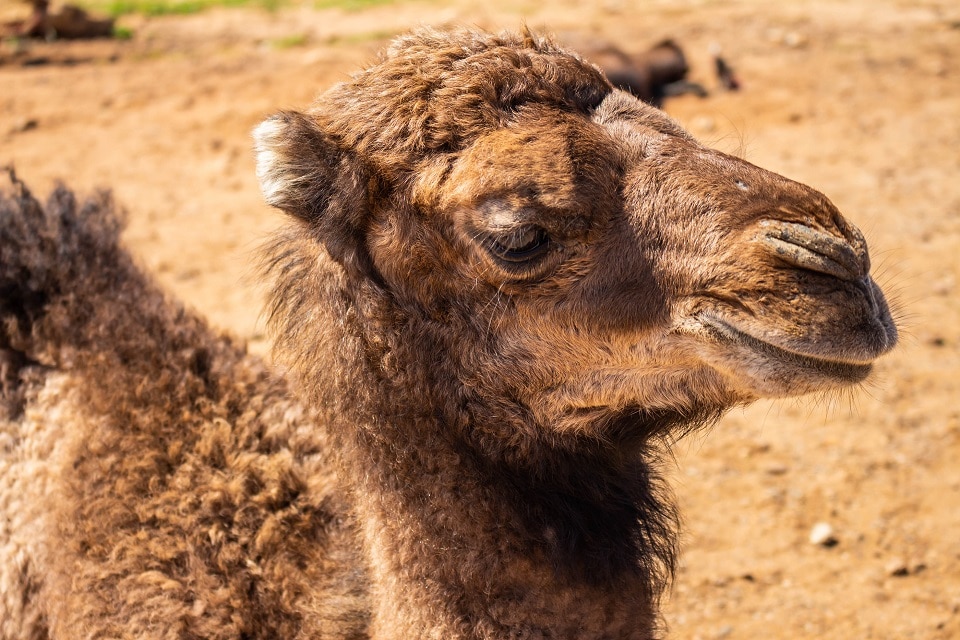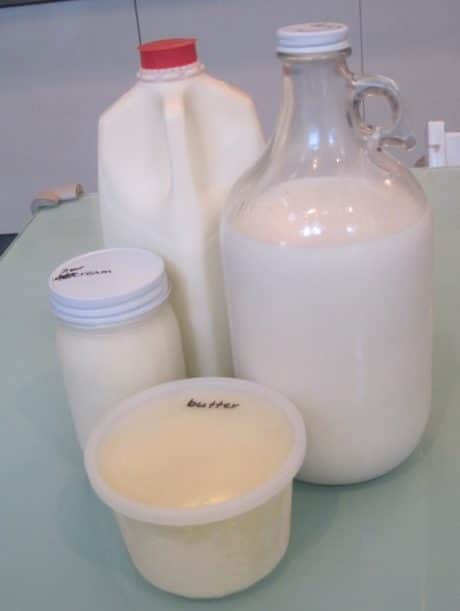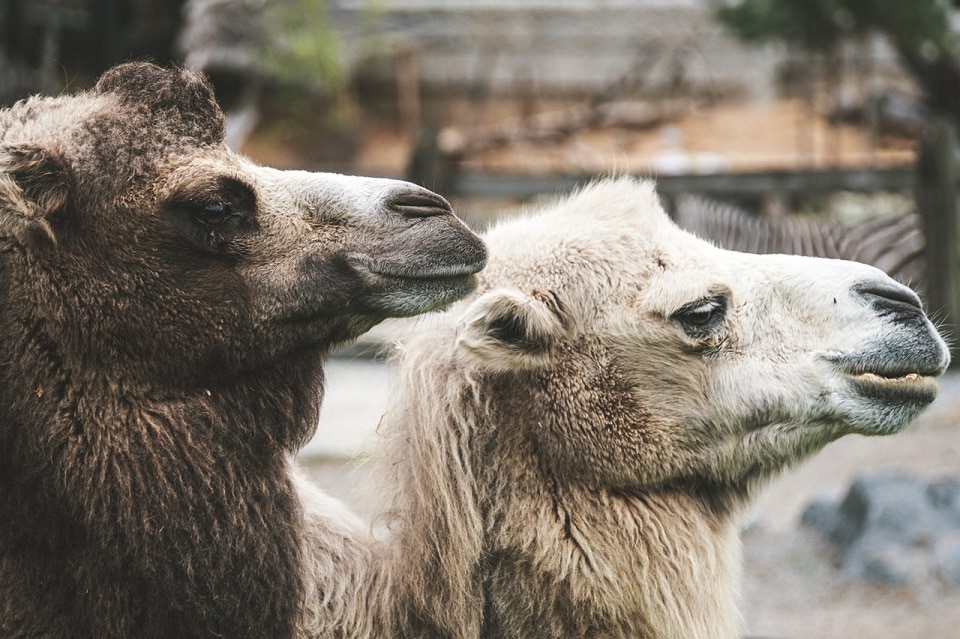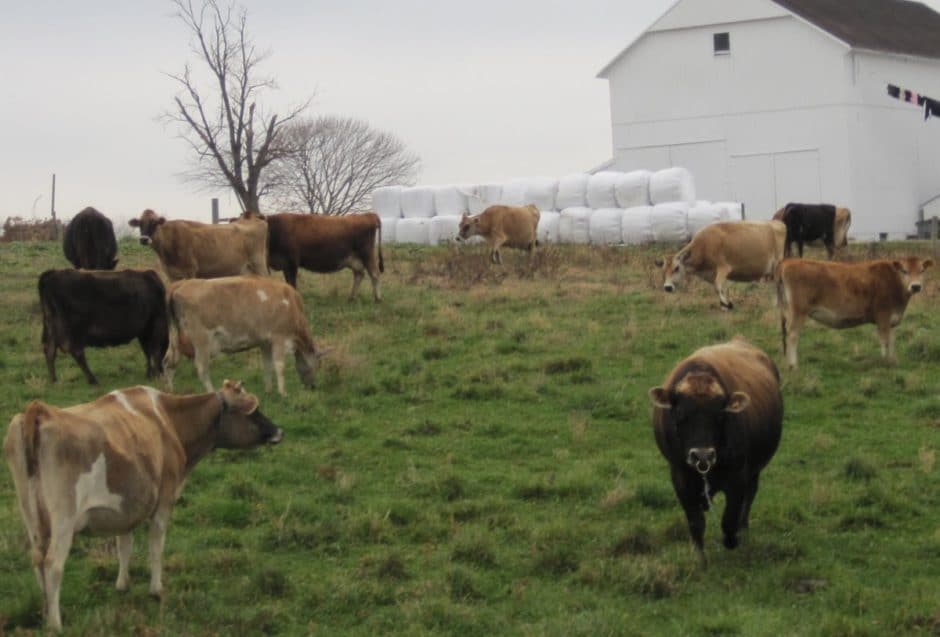Amos Miller, owner of Miller’s Organic Farm in Bird in Hand, PA, never set out to be in the camel business. In 2010, one of his employees, Ben Stoltzfus, and a friend were discussing their sons’ health complications. His friend noticed an improvement in his son’s health after camel’s milk was added to his diet. The milk came from his cousin Noah’s farm in Turbotville, PA, which was the state’s only dairy with camels at the time.

“I kind of laughed at the idea, but after doing some research, I figured it was worth a try,” says Ben. For the next year, they purchased camel milk from Noah and sold it along with other dairy, meat and dry products through their Amish organic cooperative. The demand grew fast as customers far and wide placed orders, with some customers making the trip to Lancaster County from North Carolina.
It wasn’t long before Noah’s herd could no longer keep up with the demand. Ben and Amos decided to start their own herd and purchased their first camel named Little Bit in April, 2011. A month later, they bought their second camel and the third came the next fall. Now, the herd includes a bull, three to four yearlings and five to six milking mommas.
In the summer months, the camels roam and graze the many pastures of Miller’s 55 sprawling acres. In the winter months, they are kept inside a dairy barn to avoid exposure to winter winds, and fed top-quality hay.
The Health Benefits of Camel’s Milk
For centuries, camel milk has served as a natural remedy in Middle Eastern, Asian and North African cultures. Camel’s milk is not as creamy as Jersey cow milk and it tastes like skim milk, only slightly saltier. It is 50% lower in fat and saturated fat than USDA cow’s milk, and a great source of calcium, vitamins B1 and C, iron, protein, potassium and phosphorus. It is easy to digest and is a natural probiotic that promotes gut health. It is a rich source of insulin. It lacks two allergens found in cow’s milk, making it easier to consume for people who are lactose intolerant.
 Customers purchase camel’s milk for a variety of reasons. Parents with children that have autism said it helps with temperament and relaxes the child, which makes them easier to handle. One customer used camel’s milk for skin allergies and was overwhelmed by how quickly her rash cleared up. Ben noticed a difference in his own son’s health. After his son’s liver transplant, he gets his liver enzymes tested monthly. They noticed his liver enzymes are elevated when he has little or no camel’s milk in his diet. He is also a type 2 diabetic, and it has helped stabilize his blood sugar.
Customers purchase camel’s milk for a variety of reasons. Parents with children that have autism said it helps with temperament and relaxes the child, which makes them easier to handle. One customer used camel’s milk for skin allergies and was overwhelmed by how quickly her rash cleared up. Ben noticed a difference in his own son’s health. After his son’s liver transplant, he gets his liver enzymes tested monthly. They noticed his liver enzymes are elevated when he has little or no camel’s milk in his diet. He is also a type 2 diabetic, and it has helped stabilize his blood sugar.
“It’s quite costly, but it’s primarily available for those that do not consider drugs as an option for their children. And I just love that it’s natural. It’s not something that we need to fear for side effects,” says Stoltzfus.
The Milking Process
The camels have a very unique milking system. To survive in the harsh desert, camels can turn their milk supply off to conserve energy. To produce milk, a calf must be at its mother’s side and the camels only produce milk for 90 seconds. The camels are milked twice a day with a conventional milking machine. Each camel produces a half gallon or four pints per milking.
The milk is chilled within 15 to 20 minutes of being milked. The milk is kept in a cooler for about a day and then frozen. Ben says, “We didn’t always sell the milk fresh, but we have a few customers that don’t like anything frozen. Since some customers come by and buy 10 bottles, we keep it in the cooler for a day. It can be done, it just requires a little effort.” The milk lasts up to six months in the freezer. Each bottle is marked with the camel’s initials and is delivered in hand-packed, insulated boxes.
The female camels will “freshen” or start producing milk for the first time at four years old. Their lactation period is 10 months to two years. When the calves are 15 months old, the males are sold to petting zoos and the females are kept to grow the herd.
Why Does It Cost More?
Camel products are more expensive than traditional dairy products: $15 for a pint of milk (11–30 pints cost $12.50 each and 31 or more is $11), camel kefir and yogurt are $17 a pint and camel milk soap is $6.50 a bar. Miller’s Organic Farm is one of a handful of co-ops around the country that sells dairy products from camels.

A camel’s pregnancy is 13–15 months and most often she will have one calf. There is not a very high demand for camels in the United States, which made it difficult when the co-op wanted to purchase a new camel in 2013. They only found one seller in Texas, who wanted $50,000 for the milking momma and her baby, double what the co-op has paid in the past.
Whereas a camel would cost around $100 in Saudi Arabia, shipping to Pennsylvania would cost closer to $20,000. Even then, the camel would have to be quarantined for a year or two upon arrival. According to Desert Farms, there are 18,000 cows in the U.S. for every one camel.
“Just Down-to-Earth Natural Products”
Twelve years ago, Miller’s Organic Farm was a one-farm operation and added a second farm to their property when they purchased the camels. “We added farms here and there along the years and now we have 10 farms in total. All the farms share our conscious, organic standards of chemical-free, no vaccinations, no GMOs, no hormone-enhancements, no pasteurization, just a down-to-earth natural approach as much as possible,” explained Ben.
Miller’s Organic Farm is a private membership association and customers must pay a one-time $35 membership fee to purchase products from their 300-item price list. Only about 1–2% of the co-op’s business comes from camel products. Miller’s Organic Farm product offerings include dry goods, fermented and pickled veggies, grass-fed beef, seafood, veal, poultry, lamb, milk-fed pork, ice cream and cow, sheep and goat dairy products.
Members can get their items delivered through FedEx or as a community order called a co-op. Each co-op has a coordinator who takes individual orders and coordinates drop-off times and locations. Each week, a refrigerated truck sends out 150 orders to 20 co-ops around the country, some as far-flung as Georgia, Florida, Arizona, California, Hawaii, Massachusetts and Canada. Currently, there are no co-ops in Chester County or Philadelphia. However, if enough families are interested, they are open to adding additional co-ops.
How to Become a Member
The first step is filling out a form on its website to receive an application. Once you send back the completed application and membership fee, someone from the farm will call you to welcome you to the club. To place orders or learn more, call (717) 556-0672. The farm-store hours are Monday–Friday, 8 a.m.–4:30 p.m., and by appointment on Saturday.
Miller’s Organic Farm is located at 648 Mill Creek School Rd in Bird in Hand; phone: (717) 556-0672.
- Pair of camels photo: Pexels
- Feature photo: Bigstock
- All other photos: Miller's Organic Farm






15 Comments